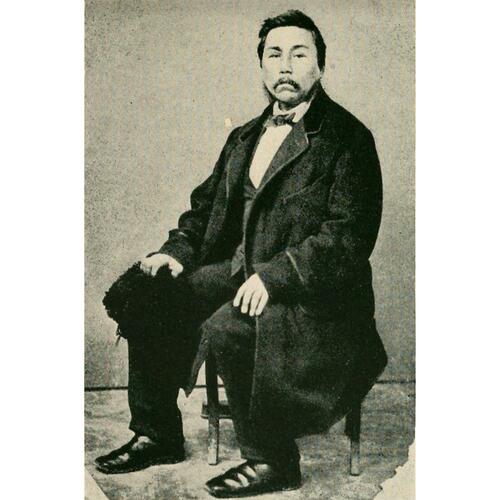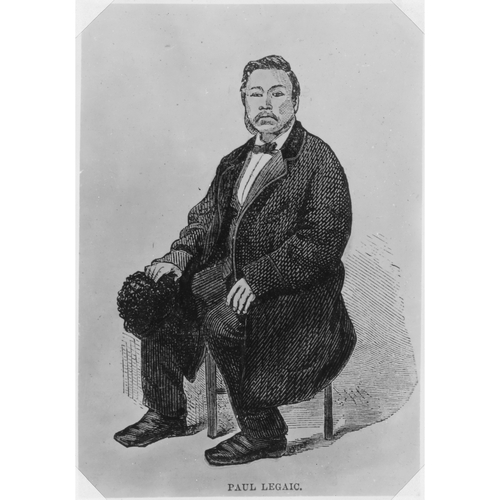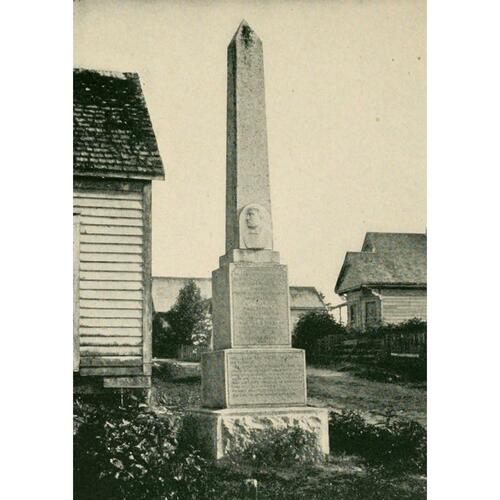![Description English: Photograph of Paul Legaic Date before 1870 Source The Apostle of Alaska [1] Fleming H. Revell Co. 1909 Author John W. Arctander (Arctander credits Benjamin A Haldane, P.E. Fisher, and E.A. Hegg in his Introduction, but images are not individually redited)
Original title: Description English: Photograph of Paul Legaic Date before 1870 Source The Apostle of Alaska [1] Fleming H. Revell Co. 1909 Author John W. Arctander (Arctander credits Benjamin A Haldane, P.E. Fisher, and E.A. Hegg in his Introduction, but images are not individually redited)](/bioimages/w600.5464.jpg)
Source: Courtesy of Wikimedia Commons
LEGAIC (Legaik, Legex), PAUL, Tsimshian chief; b. in Metlakatla (B.C.); m. Lydia, and they had at least two daughters; d. 2 Jan. 1894 in Port Simpson, B.C.
Legaic, who took the Christian name Paul at his baptism, belonged to a line of powerful coastal Tsimshian chiefs who bore the Legaic title, originally a Bella Bella name meaning “chief of the mountains.” The title was carried by at least four chiefs of the Tsimshian Eagle clan, whose traditional territories lie along the northern coast of mainland British Columbia between the mouths of the Nass and Skeena rivers. The first Legaic, probably Paul’s great-uncle, was the son of a Tsimshian Eagle woman from Metlakatla and a Bella Bella chief. When old enough, the young man returned from his birthplace at Kitimat (B.C.) to his mother’s home and was raised as the heir to his maternal uncle Chief Neyeswamak. It was this Legaic who in the second half of the 18th century built the trade empire that was to bring great wealth to the Eagles. The Legaics would come to control virtually all trade with the Hudson’s Bay Company at Fort Simpson (Port Simpson, B.C.) from their base at Metlakatla, 18 miles south of the fort. This was accomplished through the marriage in 1832 of the second Chief Legaic’s daughter to Dr John Frederick Kennedy of the HBC. Shortly after the post was moved to the site of present-day Port Simpson in 1834 the entire village, under the leadership of the second Legaic, Paul’s uncle, moved to Wild Rose Point near the new fort.
It is not known exactly when the third Legaic succeeded his uncle as chief at Fort Simpson, but it is recorded that he was head chief when William Duncan* of the Church Missionary Society arrived there in the fall of 1857. Legaic and Duncan established formal relations almost immediately. From the missionary’s viewpoint Legaic was a possible Christian convert, while from the chief’s perspective Duncan was an important addition to the Eagle clan.
In 1862 Duncan moved his mission to the old village of Metlakatla and began constructing a church and houses on a site belonging to the Eagles that came to be known as Mission Point. Initially Chief Legaic did not go with Duncan, but he made the move some months later with about 200 followers, partly in an attempt to secure the missionary as an ally in his constant struggle to maintain status, and perhaps partly to escape smallpox (an epidemic is known to have broken out at Fort Simpson shortly after Legaic left).
The struggle for status was certainly important to Legaic. By 1862 nine Tsimshian clans were living in the vicinity of Fort Simpson and, although he was recognized as the senior chief, a long-standing feud existed between his Eagle clan and the others. Legaic was able to maintain authority through the potlatch, which was, among the Tsimshians as among other native people on the northwest coast, the integrating institution through which individuals located their place within society. The Tsimshians and their neighbours had developed a hierarchical social structure based on the potlatch, but the internal safeguards of the system were for the most part lost by those groups who moved to Fort Simpson. There several chiefs of different clans were in closer contact, and thus intense competition was necessary to achieve status. The potlatches at Fort Simpson became ruinous because of the inflationary exchange called for by this rivalry.
Legaic’s position as head chief at the fort allowed him to monopolize Duncan’s attention, but in return the chief had been forced after 1857 to curtail potlatching, a practice the missionary condemned. The move to Metlakatla withdrew Legaic from rivalry with the other chiefs and made him the unchallenged head chief of his ancestral village. Through Duncan and his contacts Legaic was able to maintain his position as middleman in the trade between Indians and the HBC, and eventually to compete with the company and challenge its control of trade on the northwest coast. Legaic had a monopoly over trade with the tribes in the interior and on the northern coast, from the Gitksan-Carrier region to that of the Haidas, a territory corresponding to the commercial empire established by his predecessors. This situation changed only after the HBC was able to place a steamboat on the Skeena capable of navigating to the river forks and the post at Hazelton.
The relationship between Legaic and Duncan was not, however, always harmonious. Both were powerful and influential figures with some common goals but with competing motives, and they came into conflict over cultural matters. Legaic often found it necessary to challenge Duncan openly in order to preserve his status and authority. On one occasion the chief challenged Duncan in his church over the missionary’s attempts to influence community affairs. Legaic threatened to kill him, and ceased only when a Tsimshian convert and supporter of Duncan intervened, armed with a pistol. This was not the only battle Legaic was to lose. Eventually Duncan was able to rule Metlakatla with an iron fist, and Legaic’s influence declined accordingly. The village would become the seat of the new Anglican diocese of Caledonia in 1879, and the arrival of Bishop William Ridley would further divide loyalties.
Legaic continued to maintain many native traditions even after his baptism on 21 April 1863 by George Hills, the bishop of Columbia. The chief remained leader of the Nuhlim Secret Society; his raising of the Eagle pole at Metlakatla in 1866 was a major celebration on the coast. The potlatch on that occasion brought chiefs of the Haida, Niska, Gitksan, and Carrier nations to the village to witness the ceremony. It is said that Legaic gave slaves to his honoured guests to show his great wealth and generosity. Although he had made Metlakatla his home, he continued to maintain a house at Fort Simpson that bore a copper plaque over the lintel with the inscription: “Legaic, my crest is the Eagle, the King of the Birds, February 27, 1858.”
There is some confusion surrounding the death of Paul Legaic. Several references to him for the years before 1868 occur in the journals of HBC officer John Work* and of the American traveller Emil Teichmann, and also in the files of the 20th-century ethnologist Marius Barbeau*, but he disappears from the record for later years. The Caledonia parish records of the Church of England report that he died at Port Simpson on 6 May 1869 at the age of 55. Duncan also recorded his death on that day, attributing it to influenza. However, the British Columbia writer and historian William John O’Neill mentions in his memoirs that Paul Legaic died at Port Simpson on 2 Jan. 1894 at the age of 94. It seems unreasonable to suppose that there could have been two Paul Legaics living contemporaneously; if there were, the relationship between the two is unknown. O’Neill reports the following inscription on Paul Legaic’s tombstone: “In Memory of Chief Legaik, Died January 2, 1894, At Port Simpson – Age 95, Before he die he raise his eyes to the skies and he say, Please Lord give me two hours to live. Four hours later he die. The Lord gave him more than he ask for.”
The subsequent men who bore the Legaic title gradually ceased to play a central role on the northwest coast. Eventually the name passed out of the Tsimshian nation, and the dynasty came to an end. The last-known individual to carry the title took it in 1938. Although information is sketchy, it appears that through the influence of Christianity, Legaic may have become a surname for the descendants of Paul Legaic, while the title passed through the female line into another indigenous nation on the coast.
ACC, Diocese of Caledonia Arch. (Prince Rupert, B.C.), Port Simpson–Northern Cross file, 1863–1951. Canadian Museum of Civilization (Ottawa), Marius Barbeau, ethnographic files. Metlakatla Christian Mission (Annette Island, Alaska), William Duncan papers, journals and notebooks (mfm. at NA). PABC, Add. mss 757. Emil Teichmann, A journey to Alaska in the year 1868: being a diary of the late Emil Teichmann, ed. Oskar [Teichmann] (New York, 1963). John Work, The journal of John Work, a chief-trader of the Hudson’s Bay Co., during his expedition from Vancouver to the Flatheads and Blackfeet of the Pacific northwest, ed. W. S. Lewis and P. C. Phillips (Cleveland, Ohio, 1923). J. W. Arctander, The apostle of Alaska: the story of William Duncan of Metlakahtla (New York, 1909). I. V. B. Johnson, “The Gitksan: culture conflict on the northwest coast,” in Proceedings of the second Wilfrid Laurier University ethnohistory conference, ed. B. M. Gough (Canadian Museum of Civilization, Mercury ser., Canadian Ethnology Service paper, forthcoming, Ottawa, 1989); “The Reverend Robert Tomlinson and the Victorian missionary enterprise among the Tsimshian Indians of northern British Columbia” (ma thesis, Univ. of Waterloo, Ont., 1977). George MacDonald, “The epic of Nekt: the archaeology of metaphor,” The Tsimshian: images of the past, views for the present, ed. Margaret Seguin (Vancouver, 1984), 65–81. Peter Murray, The devil and Mr. Duncan (Victoria, 1985). E. P. Patterson, Mission on the Nass: the evangelization of the Nishga (1860–1890) (Waterloo, 1982). M. P. Robinson, The sea otter chiefs (Vancouver, 1978). H. S. Wellcome, The story of Metlakahtla (London, 1887). I. [V. B.] Johnson, “Kitwancool Jim,” Ontario Indian (Toronto), 5 (1982), no.7: 26–33.
Cite This Article
I. V. B. Johnson, “LEGAIC (Legaik, Legex), PAUL,” in Dictionary of Canadian Biography, vol. 12, University of Toronto/Université Laval, 2003–, accessed December 30, 2025, https://www.biographi.ca/en/bio/legaic_paul_12E.html.
The citation above shows the format for footnotes and endnotes according to the Chicago manual of style (16th edition). Information to be used in other citation formats:
| Permalink: | https://www.biographi.ca/en/bio/legaic_paul_12E.html |
| Author of Article: | I. V. B. Johnson |
| Title of Article: | LEGAIC (Legaik, Legex), PAUL |
| Publication Name: | Dictionary of Canadian Biography, vol. 12 |
| Publisher: | University of Toronto/Université Laval |
| Year of publication: | 1990 |
| Year of revision: | 1990 |
| Access Date: | December 30, 2025 |





